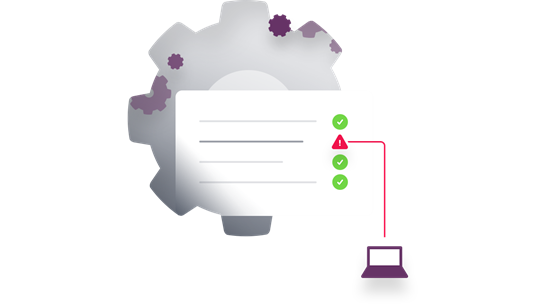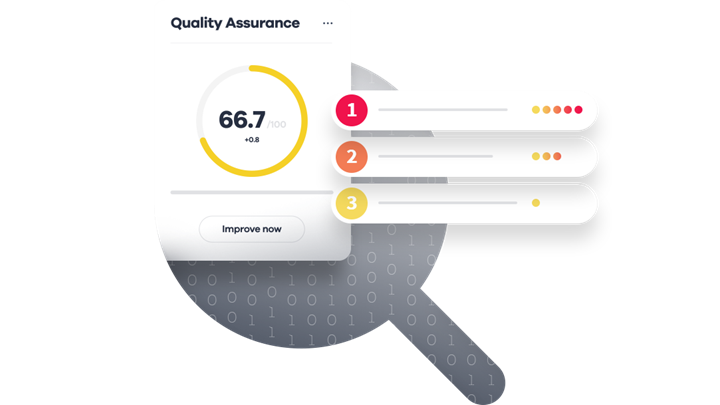Website quality assurance testing: how to optimize your user experience
As your website grows in size, complexity, and importance in achieving your business goals, the likelihood of it containing content errors, quality issues, and other user experience-damaging issues grows too.
In 2021, content quality is more important than ever before. Organizations are now more dispersed, with remote working common across teams and locations. Content contributors and website developers are creating, editing, and publishing content from around the world, in multiple languages, and with today’s coronavirus pandemic, without the usual degree of quality control. For smaller, thinly resourced organizations, or those with high turnover, it can also be near impossible to stay on top of the entirety of a site’s content, especially for industries which require regular and in-depth content updates, like e-commerce, local government, and higher education.
In this context it’s all too easy for reputation-damaging and conversion-blocking quality issues to slip through the net. And once a user has encountered this sort of error, the damage has already been done: 88% of online consumers say they are less likely to return to a site after a negative browsing experience.
This is where website quality assurance testing comes in. Regularly scanning your website(s) for quality issues will help you create and maintain the best possible user experience – and ensure you find any errors before your visitors do!

What is website quality assurance testing?
Website quality assurance testing is the process of auditing a website to detect quality issues, glitches, and bugs within your site’s content and check that everything performs the way it’s supposed to. That means checking landing page submission forms work, links go where they’re meant to, and web pages are updated with the latest information. When done correctly, the result of quality assurance testing will be a faster, cleaner, and more user-friendly website.
Website content quality issues can be broadly categorized into one of four areas:
- Content quality: The editorial quality of a site's content. Broken links, misspellings, and poor readability all contribute to a bad user experience.
- Content freshness: How current or outdated your site’s content is. Fresh content has a positive impact on user retention, engagement, and search rankings.
- Web security: How vigilant your site has been in only linking to safe domains and safeguarding sensitive user information.
- User experience: How smoothly your content aids navigation on your site. Oversized images can lead to a slower page loading speed, for example.
One of the key tenets of quality assurance testing is that it’s never finished. Every time you update your site with a new piece of content, refresh existing pages, or even add a link, quality assurance testing needs to be there to catch potential errors, maintain your site’s professionalism, and ensure an outstanding visitor experience.
Website quality assurance checklist
While most website managers know quality assurance testing needs be carried out, many don’t run through the full breadth of checks that are required to keep a site in peak working condition (it’s much more than fixing broken links) – nor know the frequency of which these checks should be conducted.
If you haven’t carried out any website quality assurance testing before, or you want to bolster your existing quality assurance process, this list of common website content quality issues is a solid place to start.
Broken links
Apart from interrupting the user’s browsing experience and calling your site’s reliability into question, a large number of broken links can also be harmful for your SEO, which is why it’s important to identify and fix them quickly – or more ideally, before they even happen. Broken links are especially difficult for larger organizations with multiple sites, redirected URLs, many external links, and other moving parts to stay on top of. It’s a good idea to prioritize fixing broken links based on analytics data, such as number of page views, page level, and importance to your marketing campaigns.
Errors in the HTML markup
Code is the foundation of your website, so if your HTML is improperly coded, you could be delivering a poor user experience to your users. Unsupported HTML tags, improperly formatted HTML, table coding errors, missing alt text, and missing scripts are all examples of the various ways in which your website code can fail to meet quality assurance standards. Not only do these issues affect your website’s functionality and performance, they also make it more difficult for visitors using assistive technologies to access your site content.
Content freshness
In addition to giving your users fresh and up-to-date information about your products and services, content is your primary tool for improving your search engine rankings. That means having an active content pipeline is essential for increasing your web traffic. It’s also advisable to regularly update the content contained within documents and media files to remove references to irrelevant or outdated information, events, or prices.
PDFs with broken links
Since PDF files tend to be hosted on individual URLs not prominently included in your site navigation, it is easy to forget them when scanning your site for broken links. But outdated PDFs or PDFs containing broken links also harm your website quality and provide a subpar user experience. You should maintain an inventory of all the PDFs on your site, or alternatively, use a tool that scans your PDFs and other media files for broken links and accessibility issues.
Broken images and videos
Images and videos help to convey visual information, can boost your SEO, and contribute to your branding efforts. Broken, slow-loading, or outdated multimedia files can severely detract from the user experience and send your users elsewhere to find what they need. Broken corporate videos and images that are meant to convey a point are most at risk – if they’re not visible, your brand messaging is completely lost. That’s why it’s so important to include transcripts and descriptive alt text. Additionally, like broken links, broken images and videos can undermine your SEO efforts by negatively impacting your site’s authority rating.
Readability
People read differently online. They tend to scan and skim. On average, a website visitor will only read 28% of your content – so you need to make sure that every piece of content is easily digestible! Auditing your page readability will identify content that is too dense or difficult to comprehend for the average visitor. It’s a good idea to test your content’s difficulty level against recognized readability tests, such as Coleman-Liau, Gunning Fog, Flesch-Kincaid Grade Level, or SMOG, to match your target audience’s reading level.
Links to unsafe domains
Secure sites don’t like to unsafe domains – it’s as simple as that. By visiting your site, users indicate that they are placing their trust in you. It’s therefore of paramount importance that you protect them when they use your site. In fact, data from PwC’s Protect.me study found that 85% of consumers will refuse to engage with a business if they have concerns about its digital security practices. A poorly built site opens itself up to cyber-attacks, phishing, and malware that could compromise user data. Every link on your website should lead to a secure (HTTPS) domain. Make sure this is the case for your website by using an unsafe domains checker to identify and remove links to risky domains.
Misspellings
Spelling mistakes are an obvious sign of carelessness and unprofessionalism. According to one study, US websites with bad grammar and spelling mistakes experienced an 85% higher bounce rate when compared to error-free sites. With automated spell-checking software widely available, there really are no excuses for misspellings in your content. Look for tools that allow you to create a custom, brand-specific dictionary to speed up and improve the accuracy of these checks.
Page speed
If you want to provide a good user experience and rank high in search engines, your site must be fast. Google uses page speed as a major ranking factor, and nearly half (47%) of consumers expect a web page to load in two seconds – or less! Remember, your pages won’t perform the same way for everyone: you need to also factor in the device they’re using, their network, and where in the world they’re located. Website speed can be a highly technical area, so it’s a good idea to use a tool to benchmark your site’s speed against industry standards and identify optimization opportunities for speeding your content load time up.

Importance of quality assurance testing in website management
Regular website quality assurance testing ensures that your website’s functionalities are performing as expected. The sooner you spot content quality and technical performance errors, the faster they can be fixed, and the better your site will perform. Some of these errors may be well hidden, or only apparent in certain situations – such as image load times based on location.
As a customer-facing asset, your website serves as a key communication channel for customers to connect with your brand and prove your credibility. Encountering a poor or frustrating user experience on your site will weaken their perception of your brand. Don’t rely on your website visitors to flag content quality issues to you either – 91% will simply disappear without leaving feedback, making a proactive approach to quality assurance testing essential.
Website quality issues don’t exist in a vacuum. Broken links, slow-loading content, and connections to unsafe domains all have a negative impact on your site’s SEO status. Search engines, including Google, routinely use user experience factors to determine your site’s placement in its search engine results. With so many contributors, large websites are most at risk, and with Google crawling and indexing web page changes at faster and faster speeds, website quality errors need to be detected in days – if not hours – rather than when they’re stumbled across, to prevent drops in traffic. That’s why it’s so important to have a continuous, far-reaching quality assurance testing system in place.
Each new website update poses a risk to your website’s quality – and none more so than a website migration or redesign. While a comprehensive content audit will catch most issues before going live, there’s always room for human error. With so many stakeholders involved in these expansive projects, it’s highly recommended to use a specialist quality assurance testing tool pre and post-deployment to catch any rogue content issues that slip through the net.
From improving your search engine optimization efforts, to enabling smoother, error-free website migrations and redesigns, to protecting your brand’s digital reputation – integrating quality assurance testing into your website management processes is a necessity.
Manual vs automated website quality assurance testing
Quality assurance testing is a time-consuming process. If you manage a large, dynamic website – or multiple websites – you should seriously consider investing in a tool that automates quality testing.
While SEO, broken link checkers, and other single-purpose tools allow you to test most content areas individually, they still require a significant manual effort, not to mention the training time needed to get on-boarded with multiple tools. What’s more, this will only count as a one-time test, whereas effective quality assurance testing really requires ongoing testing. Manual quality assurance is prone to human error, insufficient speed, and often requires a high degree of expertise to carry out properly.
Automated quality assurance testing provides a clear overview of how your site’s content is performing, as well as detecting issues in real-time. Crucially, a good quality assurance testing tool will also enable you measure the historical performance of your site to track your progress and examine the impact of your changes, such as increasing landing page conversions for key campaigns.
For larger, more complex websites and dispersed teams, automated quality assurance testing tools optimize the process of quality assurance. Automated tools typically offer a range of collaboration features designed to unite stakeholders onto a single platform, including approval workflows, change-tracking, and reporting.

Website quality assurance testing with Siteimprove Quality Assurance
Siteimprove Quality Assurance automates quality assurance checks so that nothing slips through the cracks – however large and busy your website is. Create an outstanding user experience with fresh, error-free content by:
- Quickly zeroing in on content errors before your users find them
- Prioritize content fixes based on a data-driven approach of what affects your audience most
- Unite stakeholders onto a single easy-to-use platform
- Integrate quality assurance firmly into your website maintenance processes
For those just starting out with quality assurance, or website managers who struggle to keep track of everything on their site, regain control with Siteimprove’s Content Inventory feature, which provides a full overview of every page, link, and media file on your website.
For ongoing quality assurance checks and to prevent errors before they pose a problem, make it easy for site contributors to produce on-brand, high-quality and consistent content with instant link, spelling, and readability web page checks. It’s even possible to submit individual URLs for on-the-spot checks.
Speed is of the essence when fixing site quality issues, which is why it only takes one straightforward step to integrate your chosen content management system (CMS) with Siteimprove Quality Assurance, meaning you can quickly and efficiently fix content quality errors as soon as you see them. From here, it’s simple to link your quality assurance efforts to other key website maintenance efforts, including Siteimprove Analytics, Siteimprove Performance, and other key areas that have an impact on your user experience and SEO rankings.
Lastly, your website content needs to support your brand and elevate your website above the digital competition. Track your progress towards a high-quality website and monitor peaks and dips in your content assets using progress graphs, and when it’s time to showcase your efforts, easily export your inventory to CSV or PDF to build comprehensive content audit reports that can be shared across your organization.
